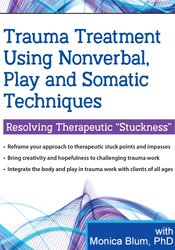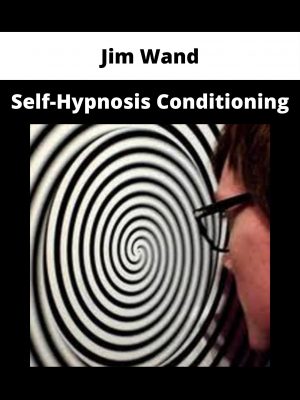Monica Blum – Trauma Treatment Using Nonverbal, Play and Somatic Techniques
$200 Original price was: $200.$75Current price is: $75.
Shopping Instructions:
- DISCOUNT 15% : SHOP15
- Product Delivery: Within 1 – 12 hours after purchase.
Watch this recording and reframe how to work with therapeutic impasses to promote movement and healing with your clients.
Monica Blum – Trauma Treatment Using Nonverbal, Play and Somatic Techniques
- Reframe your approach to therapeutic stuck points and impasses
- Bring creativity and hopefulness to challenging trauma work
- Integrate the body and play in trauma work with clients of all ages
Has your work with traumatized clients ever left you feeling stuck or like you are looping in unproductive cycles? Have you found the harder you work to help your most vulnerable clients, the more defended they seem?
If you’ve answered yes, welcome to the challenges faced by all trauma therapists.
Dr. Blum has spent her career taking the nonverbal/play-based interventions she uses with traumatized children and has “grown them up” to successfully unfold impasses in her work with traumatized adults. In this heavily experiential workshop, Dr. Blum will teach you a variety of practical, easily accessible, and intuitive nonverbal, play, and somatic-based techniques that open new pathways to shift the blocks in trauma work.
Dr. Blum interweaves practice with theory, examining how the neuroscience of trauma and attachment theory supports the importance of using the right brain-based approaches you will learn. The techniques you will practice are informed by evidence-based trauma treatments (e.g., Mindfulness, Sensorimotor Psychotherapy, Accelerated Experiential Dynamic Psychotherapy, and Play Therapy).
Watch this recording and reframe how to work with therapeutic impasses to promote movement and healing with your clients.
Through hands-on practice with a smorgasbord of nonverbal, play, and somatic interventions you will develop skills and bring new tools to your work with clients of all ages. This workshop aims to inspire your motivation, creativity, and flexibility in working with trauma.
- Reframe therapeutic impasses and how to work with it in trauma treatment.
- Substantiate the need for right brain-based modalities for effective trauma treatment.
- Articulate primary process communication and practice its use with traumatized clients.
- Plan and practice three different somatic-based interventions relevant to trauma work.
- Apply child play therapy techniques to work with traumatized adults.
- Practice two mindfulness-based techniques for grounding and affect tolerance in trauma work.
- Incorporate conscious, intentional mirroring to enhance attunement and regulate affect in traumatized clients.
Would you like to receive Monica Blum – Trauma Treatment Using Nonverbal, Play and Somatic Techniques ?
The Impasse and “Stuckness” in Trauma Treatment
- We know what stuckness looks and feels like, but what do we do with it?
- Reframe assumptions about therapeutic stuckness and impasses:
- Enactments as invitations
- Co-created stuckness
- Follow the client into the world of the right brain
- Review the role of the right brain in trauma treatment
Primary Process Communication
- The language of attachment – create security and safety
- Practice using primary process communication
“Body Language” – Somatic Interventions
- How attachment security is reflected in the language of the body
- Practice identifying and using attachment body language
- Practice body-centered listening
- Use the body to ground/become present
The Language of Play
- What are play communications?
- How to use play with adult clients
- Ball play – case example and practice
Mindfulness: Shifting from Reacting to Mindfulness and the brain
- Practice mindfulness:
- grounding, breath work
- refocusing
Mirroring: “Self” Development, Attunement, & Affect Regulation
- Mirror neurons: empathy, interoception, client validation and connection
- Intentional mirroring practice
- Increasing empathy
- Repair misattunements
- Regulate affect
- Embodied mirroring – a technique that capitalizes on therapeutic stucknes
Related products
NLP & Hypnosis
NLP & Hypnosis
NLP & Hypnosis
NLP & Hypnosis
NLP & Hypnosis
iAwake Technologies – Beginner’s Mind (Neuroflow Series) [6 WebRips – WAV User Manual – PDF]
NLP & Hypnosis
NLP & Hypnosis










![Iawake Technologies – Beginner’s Mind (neuroflow Series) [6 Webrips – Wav User Manual – Pdf]](https://copicourse.com/wp-content/uploads/2021/08/iawake-technologies-beginners-mind-neuroflow-series-6-webrips-wav-user-manual-pdf-300x400.jpg)

